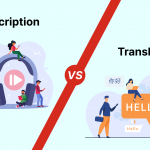
Importance of a Summary
Transcribing an audio or video file produces a secondary representation of a primary event, such as an interview, a deposition, a medical consult, or a conference or educational training presentation.
Having a written form of an audio or visual event helps in two ways:
- It serves to formally document the event, and
- It makes the content of that event available to a broader audience.
In this context, it is understandable that most clients consider the accuracy of the transcription to be one of the top three project criteria, alongside the turnaround time and the cost of the work.
In this context, it is understandable that most clients consider the accuracy of the transcription—specifically that nothing is missed—to be one of the top three project criteria alongside the turnaround time and the cost of the work.
TOO MUCH INFORMATION? SEEK TRANSCRIPT SUMMARY
In some cases, however, the level of detail captured in a verbatim transcription can exceed the needs of the end user. Those interested in reviewing the salient points of a presentation or a more condensed version of an interview might find the verbatim transcription to be unnecessarily detailed, especially if the document is not searchable or time-stamped.
The answer here is to request a summary version in addition to the full transcript.
LESS IS MORE
Often the end user wants to ‘cut-to-the-chase’ when reviewing conference or educational materials. It’s here that the ability to examine a summary document that can reduce the original length down to as much as one third can be extremely valuable. After all, time availability is your greatest concern.
However, such a content reduction requires more effort than simply deleting any material that is judged to be extraneous. Summaries come in multiple forms; each designed to serve specific purposes:
- Report Summary – a formal summary of the proceedings of a conference or event that follows an established format in order to be recognized as an official record of the event.
- Brief Summary – a more concise version that documents salient information for those who were unable to attend a conference or event and need a succinct review of the proceedings.
- Custom Summary – where the prior two options don’t meet your needs, professional transcription services can deliver a custom solution for unique audiences with specific needs such as non-technical summaries of technical presentations, or highly condensed executive summaries.
To ensure that no information is lost during this reductive process, professional transcription services will incorporate the input of subject matter experts. Because it is important to ensure that all critical data is retained in the revised versions.
A summary represents the most important reminder that transcription quality lies in the eye of the user. Project specifications that dictate accuracy, turnaround time, and cost, are often in danger of losing sight of this fact.
Yes, the transcription has to be as accurate as possible, and professional transcription services will utilize an extensive quality control process to ensure that such an outcome is achieved, but it is possible to end-up with a very user-unfriendly product at the end!
Searchability and time-stamping indeed help to make large transcription files more manageable. But for those users looking to distill the most relevant information from their perspective, time is a considerable factor. They will not ideally like to persevere through the whole document. A well written transcription summary can address this issue.







Share your thoughts